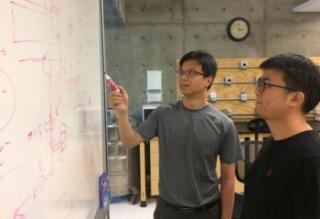Jul 10 2019
Trions may soon supersede electrons. A team of researchers headed by physicists at the University of California, Riverside, has visualized, defined, and manipulated dark trions in a semiconductor—an ultraclean single-layer tungsten diselenide (WSe2).
 Chun Hung (Joshua) Lui (left) and Erfu Liu. (Image credit: UCR/I. Pittalwala)
Chun Hung (Joshua) Lui (left) and Erfu Liu. (Image credit: UCR/I. Pittalwala)
This latest breakthrough could boost the capacity and modify the type of information transmission.
A trion is a quantum bound state of three charged particles in a semiconductor, for example, WSe2. Two electrons and a single hole are present in a negative trion, while one electron and two holes are present in a positive trion.
A hole can be defined as the vacancy of an electron in a semiconductor, which acts similar to a positively charged particle. Since a trion comprises three interacting particles, it can carry relatively more data when compared to one electron.
Most of the electronics available today utilize separate electrons to conduct electricity and relay information. Since trions are known to carry net electric charge, an electric field is enough to control their motion. Hence, trions can also be utilized as information carriers.
In addition, trions have a rich internal structure and controllable spin and momentum indices when compared to individual electrons. Through this internal structure, information can be encoded.
Trions can be classified into dark and bright trions with discrete spin configurations. An electron and a hole with opposite spins are present in a bright trion, while an electron and a hole with the same spin are present in a dark trion.
Bright trions combine robustly with light and produce light in an efficient way, which means they tend to decay rapidly. However, dark trions combine weakly with light, implying that they decay much more gradually when compared to bright trions.
The scientists then determined the dark trions’ lifetime and observed that they last over 100 times longer in comparison to the more regular bright trions. The extended lifetime allows data transmission by trions over a relatively longer distance.
Our work allows the writing and reading of trion information by light. We can generate two types of trions—dark and bright trions—and control how information is encoded in them.
Chun Hung (Joshua) Lui, Study Lead and Assistant Professor, Department of Physics and Astronomy, UC Riverside
The study results have been reported in the journal, Physical Review Letters.
“Our results could enable new ways of information transmission,” stated Erfu Liu, a postdoctoral researcher in Lui’s laboratory and the first author of the research paper. “Dark trions, with their long lifetime, can help us realize information transmission by trions. Just like increasing your Wi-Fi bandwidth at home, trion transmission allows more information to come through than individual electrons.”
A single layer of WSe2 atoms, looking like a graphene sheet, was used by the team, because in WSe2, the dark trion energy level lies under the bright trion energy level. Therefore, the dark trions can build up a huge population, facilitating their detection.
Lui informed that many trion studies that are currently performed focus only on bright trions because they produce a considerable amount of light and hence can be easily determined.
But we focus on dark trions and their detailed behavior under different charge densities in single-layer WSe2 devices. We were able to demonstrate a continuous tuning from positive dark trions to negative dark trions by simply adjusting an external voltage. We were also able to confirm dark trions’ distinct spin configuration from bright trions.
Chun Hung (Joshua) Lui, Study Lead and Assistant Professor, Department of Physics and Astronomy, UC Riverside
“If we can use trions to transmit information, our information technology will be greatly enriched,” Lui added. “The major obstacle in such a development has been the short lifetime of bright trions. Now the long-lived dark trions can help us overcome this obstacle.”
Next, Lui’s team is planning to show the actual transport of data by dark trions.
“We intend to demonstrate the first working device that uses dark trions to transport information,” Lui stated. “If such a prototype trion device works, dark trions can then be used to transport quantum information.”
UCR startup funds supported the study.
Liu and Lui were joined in the research by Jeremiah van Baren and Mashael M. Altaiary of UCR; Zhengguang Lu and Dmitry Smirnov of the National High Magnetic Field Laboratory, Florida; and Takashi Taniguchi and Kenji Watanabe of the National Institute for Materials Science, Japan.